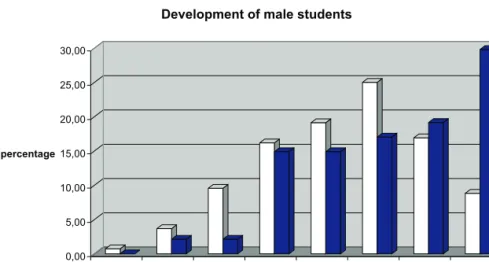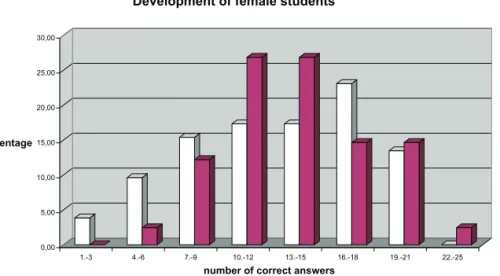34(2007) pp. 123–128
http://www.ektf.hu/tanszek/matematika/ami
Measurement of the development of spatial ability by Mental Cutting Test
Brigitta Németh
Department of Descriptive Geometry and Computer Science Szent István University
e-mail: nemeth.brigitta@ymmfk.szie.hu
Submitted 28 September 2007; Accepted 3 December 2007
Abstract
Spatial visualization of first-year engineering students has been evaluated at the beginning and at the end of the two semesters, which contain the essential Descriptive Geometry courses. The evaluation has been processed by Mental Cutting Test (MCT) which is one of the most widely used evaluation method for spatial abilities. In this paper we present an analysis of MCT results of the students, with special emphasis on gender differences. The development is found to be considerable while gender differences have became even more significant during this period.
Keywords: spatial visualization, spatial skills, MCT, gender differences MSC:51N05
1. Introduction
Spatial abilities are obviously essential in engineering studies. These abilities are not determined genetically, but rather a result of a long learning process. This fact is proved by Piaget’s experiences and examinations by twins [1]. Due to Wallon a certain minimum of spatial imagination is a common basement and requirement for all kind of intelligence [2]. Since there are various theories about intelligence itself, there are also different approaches to spatial imagination: while Lohman considers three factors of spatial abilities as visualization, spatial orientation and fast rotation [3], McGee defines it as “the ability to mentally manipulate, rotate, twist or invert pictorally presented stimuli” [16] and classifies five components of spatial skills as spatial perception, spatial visualization, mental rotations, mental relations and spatial orientation.
123
The measurement of spatial abilities is standardized by international tests, among which Mental Rotation Test (MRT) and Mental Cutting Test (MCT) are of greatest importance. Mental Rotation Test is introduced by Vanderberg and Kuse [17], while Mental Cutting Test, originally developed for entrance examination in the United States [18], has a long history and widely used for testing the spatial ability of students at any level. Other tests can also be mentioned like Objective Test on Orthographic Projection (OTO) evaluating the effects of the education in orthographic view [6], or Space Imagination Test (TPP) developed by interna- tional cooperation in VEGA project [10], or a test by Guay entitled Purdue Spatial Visualization Test [4]. This latter test consists of three parts: Developments, Ro- tations and Views. Developments consists of 12 questions designed to see how well students can visualize the folding of developments into three-dimensional objects.
Rotations consists of 12 questions to evaluate the visualization of the rotation of three-dimensional objects. Finally Views consists 12 questions to visualize how three-dimensional objects look like from various viewing positions. Similar test has been applied in [13].
The aim of this paper is to evaluate classical MCT test results of first-year engineering students in Hungary, with special emphasis on gender differences.
2. The Mental Cutting Test
In our project we used the standard Mental Cutting Test, which consists of 25 problems. In each problem a perspective drawing of a solid body is given, which has been cut by a plane. Students are asked for choosing the cross section among the 5 given alternatives, always one being correct.
Basically there are two different types of problems can be found in MCT: pattern recognition problems and quantity problems [7]. In the first category one can find strongly different alternatives of possible cross sections, thus the right solution can be found simply by recognizing the pattern of the section from the spatial figure.
In the quantity problems, however, some of the cross sections are similar (more precisely affine) to the correct one, thus the right answer can be determined only by guessing the relative quantities, like ratios of lengths or angles between the edges.
Most of the solids in MCT have relatively complicated, unusual forms, some of them are truncated cubes, others are curved objects, like cylinders. As Tsutsumi et al. reported in [8], failures are mostly based on the fact that students are not able to recognize the spatial form of the object.
3. Results - Improvement of spatial ability
Here we used the classical MCT test for first-year engineering students of Szent István University. At the beginning of the first semester 250 students filled the MCT test, third of them being females. Based on these tests gender differences
have been studied in [14], while typical mistakes have been observed and examined in [15].
Figure 1: Correct answers at the beginning of the first semester (white) and at the end of the second semester (dark).
At the end of the second semester, which included various descriptive geometry studies, like Axonometry, Monge-projection and partly Perspective Drawing, more than 100 tests have been filled by these students. Main purpose of our study was to evaluate the improvement of spatial abilities after these Descriptive Geometry courses. Diagram in Fig. 1 shows the overall development of the students, where the improvement is obvious, especially in the lowest and highest rankings. Means of the results before and after the semesters show statistically significant difference at the level of 98% by one-sample t-test [5].
There are few problems where the results were lower at the end of the year.
These are all quantitative problems, that is sections are closely related in structure, differing only in lengths and angles. These problems seem to be the hardest ones for the students.
Figure 2: Problem 118: section of a cylinder.
In problem 118 (Fig. 2), however the improvement was more than 20%. This is the section of a cylinder, which is studied at the end of the second semester, thus students may remember well for this problem .
Gender differences were also evaluated before and after the semesters. At the beginning of the semester, similarly to the results of Tsutsumi [7], we observed significant difference between male and female students [14, 15].
At the end of the semester this difference were also significant, measured by two-sample t-test [5]. As one can observe in diagrams of Fig. 3 and Fig. 4, the improvement of spatial ability is even higher for male students, which yields that gender differences were getting stronger.
Male students achieved especially high degree improvement in the highest range (between points 22–25), from 8.82% to 29.79%, but development is also remarkable in the second highest range (between point 19–21) (Fig. 3).
For female students the improvement of spatial ability is not as remarkable and obvious, as for males. There is good improvement in the lowest range (between points 0–9), and some development (although far from that one by males) in the highest range (between points 19–25). The most obvious improvement can be observed in the middle range (between points 10–15) (Fig. 4).
These results support our strong belief that teaching descriptive geometry can highly improve the spatial ability of students. However this improvement is more reliable in the case of male students, female engineering students can also gain some extra ability during these courses, especially those who had only limited spatial imagination previously.
Figure 3: Improvement of spatial ability of male students.
Figure 4: Improvement of spatial ability of female students.
4. Conclusion and further research
Spatial imagination of engineering students has been studied in this paper.
Their abilities were tested by the standard MCT tool which is widely used for this purpose. In accordance with the international experiences we observed relevant improvement after two semesters of descriptive geometry courses. Differences in male and female students’ abilities, however, remained the same, development of male students was more significant. Future work will be focused on longitudinal research with regular testing periods along their university studies.
References
[1] Inhelder, B., Piaget, J., A gyermek logikájától az ifjú logikájáig. A formális műveleti struktúrák kialakulása,Akadémiai Kiadó, Budapest, 1967.
[2] Wallon, H., Délire de persécution. Le délire chronique a base d’interprétation, Bailliere, Paris, 1909.
[3] Lohman, D.F., Nichols, P.D.,Training spatial abilities: Effects of practice on rotation and synthesis tasks,Learning and Individual Differences,2(1990), 67–93.
[4] Guay, R.B., Purdue Spatial Visualization Test,Purdue Research Foundation,1976.
[5] Guilford, J.P., Fundamental Statistic in Psychology and Education, McGraw Hill, New York, 1965.
[6] Takeyama, K., Maeguchi, R., Chibana, K., Yoshida, K., Evaluation of Objec- tive Test using a pair of orthographic projections for descriptive geometry,Journal for Geometry and Graphics,3(1999), 99–109.
[7] Tsutsumi, E., A Mental Cutting Test using drawings of intersections, Journal for Geometry and Graphics,8(2004), 117–126.
[8] Tsutsumi, E., Shiina, K., Suzaki, A., Yamanouchi, K., Takaaki, S., Suzuki, K., A Mental Cutting Test on female students using a stereographic system,Journal for Geometry and Graphics,3(1999), 111–119.
[9] Gorska, R., Sorby, S., Leopold, C., Gender differences in visualization skills - an international perspective,The Engineering Design Graphics Journal,62, (1998), 9–18.
[10] Juscaková, Z., Gorska, R., A pilot study of a new testing method for spatial abilities evaluation,Journal for Geometry and Graphics,7(2003), 237–247.
[11] Gorska, R., Spatial imagination - an overview of the longitudinal research at Cra- cow University of Technology,Journal for Geometry and Graphics,9 (2005), 201–
208.
[12] Gorska, R., Sorby, S., Leopold, C., International comparisons of gender differ- ences in spatial visualization and the effect of graphics instruction on the develop- ment of these skills, Proc. of the 8th Intl. Conf. of Engineering Comp. Graph. and Descriptive Geom. (ICECGDG), Austin, USA, 1998, 261–266.
[13] Nagy-Kondor, R., Spatial ability of engineering students,Annales Mathematicae et Informaticae, Vol. 34 (2007), 113–122.
[14] Németh, B., Hoffmann, M., Gender differences in spatial visualization among engineering students.Annales Mathematicae et Informaticae,31(2006), 169–174.
[15] Németh, B., Sörös, Cs., Hoffmann, M., Typical mistakes in Mental Cutting Test and their consequences in gender differences,Teaching Mathematics and Com- puter Science(to appear).
[16] McGee, M.G., Human Spatial Abilities: Psychometric studies and environmental, genetic, hormonal and neurological influences,Psychological Bulletin,86, 899–918.
[17] Vanderberg, S.G., Kuse, A.R., Mental Rotations, a group test of three dimen- sional spatial visualization,Perceptual and Motor Skills,47(1978), 599–604.
[18] CEEB Special aptitude test in spatial relations, College Entrance Examination Board, USA, 1939.
Brigitta Németh
Department of Descriptive Geometry and Compute Science Szent István University
Thököly str. 74.
H-1146 Budapest, Hungary


